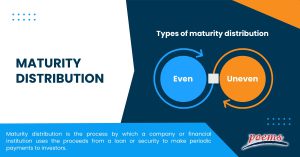Maturity distribution
Table of Contents
Maturity distribution
When it comes to investor pitch decks, the most important section is maturity. This is where the future value of your company is projected based on growth rates.
In finance, a maturity date is when a financial asset (a loan, bond, or note) is due for repayment.
The problem with measuring maturity distribution is that it is not something anyone talks about. It is not a term you hear daily, but it should be. It is a vital concept for investors as it helps them understand how markets work and how to manage their portfolios.
To develop a strategy to put your company at the forefront of your market and give it an edge, it is important to understand your maturity distribution.
Here, we look at maturity distribution and how investors can use it to hedge their portfolios.
What is maturity distribution?
Maturity distribution is the process by which a company or financial institution uses the proceeds from a loan or security to make periodic payments to investors. The payments are usually made at regular intervals, such as monthly or quarterly. The payment may be made in different amounts, depending on the terms of the loan or security.
Understanding maturity distribution
Maturity distribution is a technique financial institutions use to manage the risk associated with investments. It is a process of allocating funds across different asset types and maturity dates to create a more balanced portfolio.
The goal of maturity distribution is to protect the investment portfolio’s value from market volatility and interest rate risk. By spreading funds across different asset types and maturity dates, the portfolio is less likely to be impacted by sudden changes in the market.
Maturity distribution can be used to manage both fixed-income and equity portfolios. For fixed-income portfolios, funds are typically allocated across different bonds with different maturities. For equity portfolios, funds may be distributed across other stocks with varying expiration dates.
The exact allocation of funds will depend on the portfolio’s specific goals and the financial institution’s investment strategy. However, the goal is always to create a more balanced and diversified portfolio less susceptible to market volatility.
What is the maturity distribution model?
A maturity distribution model is a statistical tool used to predict future cash flows for a given security. The model employs a set of underlying assumptions about the security’s price behavior to generate a set of projected cash flows. Fixed-income investors typically use the model to estimate the expected return of a security over its lifespan.
The model’s underlying assumptions are that the security’s price will follow a normal distribution, and the security’s price will be mean-reverting. The model also assumes that the security’s price will be affected by several factors, including interest rates, dividends, and credit risk. The model’s predictions are based on these assumptions and are meant to provide a guide for future price behavior.
The maturity distribution model is helpful for fixed-income investors, but it should be used cautiously. The model’s predictions are based on several assumptions, which may not hold in all cases. Investors should always conduct their research before making any investment decisions.
Impact of maturity distribution
The maturity distribution of a portfolio is an essential factor to consider when assessing risk and return potential. A portfolio with a higher proportion of shorter-dated securities is generally considered riskier than one with a higher proportion of longer-dated securities. This is because shorter-dated securities are more sensitive to changes in interest rates and are, therefore, more volatile.
The maturity distribution of a portfolio can also impact the return potential of the portfolio.
Types of maturity distribution

There are generally two types of maturity distribution: even and uneven.
- Even maturity distribution
Even maturity distribution means that the maturities of the underlying securities in the portfolio are distributed evenly. For example, if a portfolio has 100 securities, each security will mature in one year.
- Uneven maturity distribution
Uneven maturity distribution means that the maturities of the underlying securities are not distributed evenly. For example, a portfolio might have 50 securities maturing in one year and 50 in two years.
Frequently Asked Questions
Maturity distribution measures the durations of the bonds in a portfolio. Duration, on the other hand, is a measure of a bond’s price sensitivity to changes in interest rates. Duration is a key concept in fixed-income investing, as it measures a bond’s risk.
There is no one-size-fits-all answer to this question, as maturity in business can mean different things for different organisations. However, in general, maturity in business refers to the ability of an organisation to effectively and efficiently manage its operations, resources, and people.
A mature organisation typically has a well-defined strategy and can execute it flawlessly. They have solid processes and systems, and their people are highly skilled and dedicated to their work. In short, a mature organisation can operate at a high level and consistently produce excellent results.
The Fed Balance Sheet Maturity Distribution is the distribution of maturities of the securities held by the Federal Reserve. The distribution is important because it shows the Fed’s assets’ composition and average maturity. The distribution is also a key factor in the Fed’s ability to control interest rates.
The maturity date formula is used to calculate the date on which a financial instrument will mature. The formula considers the issue date, the interest rate, and the number of days in the term.
The maturity date formula is:
Maturity date = date of issue + (interest rate * number of days in term).
The US Treasury maturity distribution is the percentage of US Treasury securities that mature in a given time period. The distribution is important because it provides information on the debt the US government will need to finance in the future. The distribution is also used to measure US Treasury securities’ risk.
Related Terms
- Trailing Stops
- Exchange Control
- Relevant Cost
- Dow Theory
- Hyperdeflation
- Hope Credit
- Futures contracts
- Human capital
- Subrogation
- Qualifying Annuity
- Strategic Alliance
- Probate Court
- Procurement
- Holding company
- Harmonic mean
- Trailing Stops
- Exchange Control
- Relevant Cost
- Dow Theory
- Hyperdeflation
- Hope Credit
- Futures contracts
- Human capital
- Subrogation
- Qualifying Annuity
- Strategic Alliance
- Probate Court
- Procurement
- Holding company
- Harmonic mean
- Income protection insurance
- Recession
- Savings Ratios
- Pump and dump
- Total Debt Servicing Ratio
- Debt to Asset Ratio
- Liquid Assets to Net Worth Ratio
- Liquidity Ratio
- Personal financial ratios
- T-bills
- Payroll deduction plan
- Operating expenses
- Demand elasticity
- Deferred compensation
- Conflict theory
- Acid-test ratio
- Withholding Tax
- Benchmark index
- Double Taxation Relief
- Debtor Risk
- Securitization
- Yield on Distribution
- Currency Swap
- Overcollateralization
- Efficient Frontier
- Listing Rules
- Green Shoe Options
- Accrued Interest
- Market Order
- Accrued Expenses
- Target Leverage Ratio
- Acceptance Credit
- Balloon Interest
- Abridged Prospectus
- Data Tagging
- Perpetuity
- Hybrid annuity
- Investor fallout
- Intermediated market
- Information-less trades
- Back Months
- Adjusted Futures Price
- Expected maturity date
- Excess spread
- Quantitative tightening
- Accreted Value
- Equity Clawback
- Soft Dollar Broker
- Stagnation
- Replenishment
- Decoupling
- Holding period
- Regression analysis
- Wealth manager
- Financial plan
- Adequacy of coverage
- Actual market
- Credit risk
- Insurance
- Financial independence
- Annual report
- Financial management
- Ageing schedule
- Global indices
- Folio number
- Accrual basis
- Liquidity risk
- Quick Ratio
- Unearned Income
- Sustainability
- Value at Risk
- Vertical Financial Analysis
- Residual maturity
- Operating Margin
- Trust deed
- Leverage
- Profit and Loss Statement
- Junior Market
- Affinity fraud
- Base currency
- Working capital
- Individual Savings Account
- Redemption yield
- Net profit margin
- Fringe benefits
- Fiscal policy
- Escrow
- Externality
- Multi-level marketing
- Joint tenancy
- Liquidity coverage ratio
- Hurdle rate
- Kiddie tax
- Giffen Goods
- Keynesian economics
- EBITA
- Risk Tolerance
- Disbursement
- Bayes’ Theorem
- Amalgamation
- Adverse selection
- Contribution Margin
- Accounting Equation
- Value chain
- Gross Income
- Net present value
- Liability
- Leverage ratio
- Inventory turnover
- Gross margin
- Collateral
- Being Bearish
- Being Bullish
- Commodity
- Exchange rate
- Basis point
- Inception date
- Riskometer
- Trigger Option
- Zeta model
- Racketeering
- Market Indexes
- Short Selling
- Quartile rank
- Defeasance
- Cut-off-time
- Business-to-Consumer
- Bankruptcy
- Acquisition
- Turnover Ratio
- Indexation
- Fiduciary responsibility
- Benchmark
- Pegging
- Illiquidity
- Backwardation
- Backup Withholding
- Buyout
- Beneficial owner
- Contingent deferred sales charge
- Exchange privilege
- Asset allocation
- Letter of Intent
- Emerging Markets
- Consensus Estimate
- Cash Settlement
- Cash Flow
- Capital Lease Obligations
- Book-to-Bill-Ratio
- Capital Gains or Losses
- Balance Sheet
- Capital Lease
Most Popular Terms
Other Terms
- Options expiry
- Adjusted distributed income
- International securities exchanges
- Settlement currency
- Federal funds rate
- Active Tranche
- Convertible Securities
- Synthetic ETF
- Physical ETF
- Initial Public Offering
- Buyback
- Secondary Sharing
- Bookrunner
- Notional amount
- Negative convexity
- Jumbo pools
- Inverse floater
- Forward Swap
- Underwriting risk
- Reinvestment risk
- Final Maturity Date
- Payment Date
- Secondary Market
- Margin Requirement
- Mark-to-market
- Pledged Asset
- Yield Pickup
- Subordinated Debt
- Treasury Stock Method
- Stochastic Oscillator
- Bullet Bonds
- Basket Trade
- Contrarian Strategy
- Notional Value
- Speculation
- Stub
- Trading Volume
- Going Long
- Pink sheet stocks
- Rand cost averaging
- Sustainable investment
- Stop-limit sell order
- Economic Bubble
- Ask Price
- Constant prepayment rate
- Covenants
- Stock symbol
- Companion tranche
- Synthetic replication
- Bourse
Know More about
Tools/Educational Resources
Markets Offered by POEMS
Read the Latest Market Journal

本文旨在为中级外汇交易者提供必要的信息和知识。它将涵盖我们上一篇文章 “五分钟看懂世界上最活跃的市场-外汇差价合约(FX CFD)...

解锁台湾股市的投资潜力!深入了解由强大的技术驱动型经济推动的股票市场,2023 年机械和电气设备将占出口的 69%。在政治稳定、投资者友好的法规和健全的法律框架下,探索台积电和富士康等全球顶级企业。台湾股市值得称赞的历史表现和在国际贸易中的的重要性使其更具吸引力。在这个科技实力雄厚、经济稳定、充满活力的股票市场中,抓住增长机遇!

了解外汇市场 外汇交易市场又称外汇市场,是一个买卖货币的全球性金融市场。它是全世界规模最大、流动性最强的金融市场,每日交易量超过 6 万亿美元。但外汇市场有一个重要却常被忽视的一点,就是它受交易心理的影响。在本文中,我们将探讨外汇市场的复杂性,还有把重点放在交易心理与传统交易策略共同发挥的关键作用...

五分钟看懂世界上最活跃的市场 -外汇差价合约(FX CFD)
外汇交易市场俗称外汇或外汇市场,是全球金融市场的支柱。它是世界上最活跃的市场,2022 年 4 月,全球交易额达到创纪录的每天 7.5 万亿美元[1] 。这个活跃的市场为交易者提供了利用货币价格波动赚取利润的机会。在本文中,我们将解释外汇市场的基本原理,助您了解其投资机制。 什么是外汇? 外汇市场是一个分散的全球市场,世界上所有货币都在这里进行交易...

随着通胀数据趋向 2% 的理想目标,人们普遍乐观地认为,在任何可能的降息之前,市场都不会受到不利影响。以下是美股市场2024年的一些重要事件,投资者在做出投资决策时可以参考留意。

根据《东南亚态势报告:2023》,失业和经济衰退是当前东南亚面临的主要挑战。各国采取了各种政策和措施以恢复经济,尽力摆脱新冠疫情的影响。尽管如此,越南在经济和社会方面展现出了令人满意的复苏迹象,经济增长逐季上升,成为世界经济的亮点之一。虽然全年GDP增速放缓至5.05%,低于政府6.5%的目标,但越南仍然是地区和世界经济增速较快的国家之一。






















